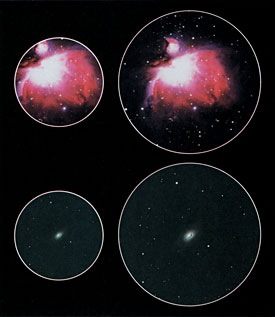
Would a large concave mirror suffice for low-power views of extended deep-sky objects?
A large concave mirror, even of low quality, has lots of light-collecting power. Would such a mirror suffice for low-power views of extended deep-sky objects, even if it didn't show stars as neat dots? For example, a 20-inch plastic mirror might be fairly inexpensive. My 7th-grade science teacher once let…

Where did the 1 1/4-inch standard size for eyepiece barrels come from?
Where did the 1 1/4-inch standard size for eyepiece barrels come from? This barrel size was adopted shortly before 1890 by John A. Brashear in Pittsburgh, Pennsylvania, says Bart Fried of the Antique Telescope Society. Then W. & D. Mogey of Plainfield, New Jersey, and other firms followed suit.…

What should I do if my telescope mirror is dusty?
I took my new scope out last night and pointed a flashlight down the tube. My mirror looks really dusty. What should I do? The answer is simple: Don’t shine a light down the tube at night! Seriously, it only makes the dust look a lot worse than it is.…

How Can I Prevent My Finder From Dewing Over?
How do I keep my finder from dewing over when I observe? Your finder should have a light shield (“dewcap”), which you can cover between uses. Or you can purchase an anti-dewing device. This need not be expensive. You probably have a box full of them at home: A simple…

Where can I find double star SAO numbers for my Go To telescope?
I want to observe double stars, but my Go To telescope needs their SAO numbers. Where can I get them? SAO numbers come from the Smithsonian Astrophysical Observatory Star Catalog (1966). They aren’t normally used by double-star enthusiasts, who prefer special notations such as ADS 1630, S748, and Krueger 60.…

Should I wear eyeglasses while observing?
Should I wear eyeglasses while observing? If you are near-or farsighted, with no other eye problems, definitely take them off. You’ll have to tweak the focus, but you’ll see objects in the telescope just as clearly as if you had 20:20 vision. By taking off your glasses you’ll avoid the…

How can I get my German equatorial mount to hold its tilt?
My old German equatorial mount won't hold the proper tilt for my latitude. What can I do? Believe it or not, grease the threads and washer of the large bolt that clamps the polar-axis housing to the tripod head. Then tighten it. — Dennis di Cicco

What's the difference between two Plössl eyepieces?
I bought exactly the same Plössl eyepiece that a buddy has, but mine doesn’t work as well as his. Did I get a lemon? That’s possible, but very unlikely. Our guess is that your telescope has a short focal ratio, perhaps f/5 or less, while your friend may have an…

How can eyepieces offer a telescope's widest true field?
Some eyepieces are being advertised as offering the widest possible true field in any telescope. How is this determined? The amount of sky shown by an eyepiece is governed by the diameter of its field stop, the ring that defines the edge of the visible field. On a given telescope,…

How can I polar align in the daytime?
I want to see a planetary transit. How can I polar align my telescope in the daytime? One good way is to use the Sun. Carefully level your mount with a bubble level and set the polar axis to the latitude of your site. Hang a weighted string from the…
How do I clean eyepiece lenses?
Very carefully — and not often! Here are some tips to help you keep your optics clean.

Choosing Your Astronomy Equipment
How to Choose Your Telescope Magnification
How high can you get? How low can you go? The answers depend on many factors that combine to give each telescope a useful magnitude range.

Accurate Polar Alignment with Your Telescope
Long-exposure astrophotography requires an accurately aligned equatorial mount.
Equipment: Guides & Recommendations
Thermal Boundary Layers in Newtonian Reflectors
Assessing your telescope's state of cooling is the first step on the road to optimal performance.
